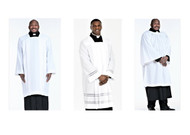The Power of Surplices in Building Bridges: Promoting Ecumenical Relations and Gender Inclusivity
Mar 14th 2023
In today's interconnected world, interfaith understanding and cooperation have become essential for peaceful coexistence.
Coming together in joint worship services and other interfaith events is an important way for Christian groups to develop bridges of understanding despite their shared faith but frequently divergent traditions and rituals.
Surplices, a type of liturgical vestment worn by clergy members during certain religious services, play an important role in facilitating ecumenical relations between different Christian denominations.
In this article, we will examine the significance of surplices in promoting ecumenical relations, their use in joint worship services and other interfaith activities, and how buying surplices here at DivinityClergyWear.com can make the purchasing experience more convenient.
Understanding Surplices
Surplices are traditionally white, linen, or cotton vestments worn over a cassock or other type of undergarment. They may be paired with a stole or another form of a scarf and feature delicate lacework or embroidery.
From the earliest days of Christianity, men in the clergy have been expected to wear surplices. All sacraments, including Communion, and baptism, involve the wearing of special garments by the minister performing the rite.

The Role of Surplices in Ecumenical Relations
One of the key ways in which surplices promote ecumenical relations is through their use in joint worship services. Surplices are a great way for Christians of different traditions to feel more united during collective worship.
Surplices provide a visual reminder of the shared faith and beliefs of those present and help to emphasize the importance of cooperation and understanding between different denominations.
Surplices also play an important role in other interfaith activities, such as conferences, seminars, and other gatherings. When clergy members wear surplices during these events, they signal a commitment to dialogue and cooperation and help to create an atmosphere of mutual respect and understanding.
This can be particularly important in areas of the world where religious tensions are high, as it can help to defuse potential conflicts and promote peace.
Understanding Surplices and Gender in the Clergy
Surplices are traditionally white, linen, or cotton vestments worn over a cassock or other type of undergarment by members of the clergy during religious services.
Historically, the use of surplices has been limited to male members of the clergy, reflecting the patriarchal structures of many religious institutions.
Women and non-binary individuals have often been excluded from wearing surplices or other types of liturgical vestments, reflecting a wider exclusion from positions of authority and leadership within religious settings.
Matter of fact, in recent years, religious institutions have made greater strides toward fostering diversity and gender equality.
A more inclusive and equitable attitude to religious leadership can be seen in the fact that women pastors and non-binary people are increasingly permitted to wear surplices and other liturgical vestments by many religions.
The Evolving Role of Surplices in Promoting Gender Inclusivity and Diversity
Women pastors and non-binary individuals who choose to wear surplices in religious contexts can play a significant role in normalizing gender diversity and inclusion. Having persons of both sexes wear surplices in a church might give a message of inclusiveness and equality to the congregation.
In addition, the use of surplices by women and non-binary individuals can help to challenge traditional gender roles within religious institutions.
Allowing people of both sexes to wear surplices and other liturgical vestments is a progressive and inclusive way for religious institutions to demonstrate their support for gender equality and diversity.
Clergy Surplices Today
More styles of surplices are being worn by the clergy now than ever before, a trend that reflects the evolving character of religious institutions and their place in contemporary society.
Several religious groups continue to wear surplices as a sign of respect and authority, but the garment is also being reimagined and reinvented to meet the requirements of modern congregations.
In modern worship services that feature elements of popular culture like rock music, dance, and multimedia presentations, surplices are often worn.
Surplices, along with other liturgical vestments or even casual attire, are appropriate in these contexts because they indicate a more casual and less formal approach to religious devotion.
Buying Surplices at DivinityClergyWear.com
At DivinityClergyWear.com, we offer a wide range of high-quality surplices that are perfect for use in joint worship services and other interfaith activities.
Each of our surplices is carefully crafted from high-quality fabrics to ensure maximum comfort and longevity. All clergy members can find them in a variety of sizes and styles that can be altered to incorporate embroidery or other embellishments.
Aside from our superior quality surplices, we also provide a variety of other liturgical vestments and accessories, such as cassocks, stoles, albs, and more. In addition to being reasonably priced, our products are tailored to the requirements of ministers of all faiths.
When you shop at DivinityClergyWear.com, you can enjoy a hassle-free shopping experience that is designed to make purchasing surplices and other liturgical vestments easy and convenient.
